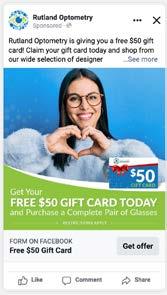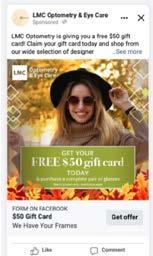TO UNDERSTANDING GOOGLE ADS AND FACEBOOK ADS






Overview of Google Ads and Facebook Ads ...........................................................................................
Key Differences Between the Two Platforms ..........................................................................................
a. Ad Types ...............................................................................................................................
b. Targeting Options ...........................................................................................................................
c. Cost & Metrics ...............................................................................................................................
Pros and Cons of Each Platform ...........................................................................................................
When to Use Each Platform ..................................................................................................................

Tips for Successful Ad Campaigns ........................................................................................................
Next Steps ...............................................................................................................................


TABLE OF CONTENTS




........................................................................................... 4 .......................................................................................... 6 ......................................................................................................................................... 7 ........................................................................................................................... 9 ............................................................................................................................... 10 ........................................................................................................... .................................................................................................................. ........................................................................................................ ............................................................................................................................... CONTENTS
OVERVIEW OF GOOGLE ADS



Google Ads and Facebook Ads are two of the most popular advertising platforms available today. Google Ads allows you to place ads on search engine results pages (SERPs) and websites that are part of the Google Display Network (GDN). Facebook Ads, on the other hand, are displayed within the Facebook platform and its associated apps (Instagram, Messenger, etc.). Both platforms serve different purposes in the patient cycle and can be used to help you reach a variety of goals for your practice.
GOOGLE ADS
Google Ads is a powerful platform that enables businesses to create highly targeted ad campaigns that reach potential customers, increase brand visibility, and generate leads. It has become one of the most popular digital marketing tools because of its wide variety of targeting options and cost-effectiveness. With Google Ads, advertisers can target specific demographics such as age, gender, location and interests.
Ads are displayed on the Google Display Network (GDN), which includes websites like YouTube, Gmail and other Google products. Advertisers have the option to bid for each click or impression they receive from the GDN. The cost per click (CPC) or cost per thousand impressions (CPM) is determined by an auction-style

THE ULTIMATE GUIDE TO UNDERSTANDING GOOGLE ADS AND FACEBOOK ADS
AD HERE AD HERE AD HERE Regular Text Ad
ADS AND FACEBOOK ADS



system known as AdRank, which ranks ads according to their relevance and quality score. This helps ensure that advertisers only pay for ads that reach their intended audience.
FACEBOOK ADS
Facebook Ads is an effective advertising platform for practices of all sizes and budgets. The platform allows advertisers to create targeted campaigns based on demographic information such as age, gender, location, interests, activities and more. Facebook Ads are based on an auction system where advertisers bid against each other to display their ads in the News Feeds of Facebook users. The higher the bid, the higher the chance of winning an auction in order to deliver a particular ad. This system ensures that only the most relevant ads are shown to users and helps prevent click fraud.
Advertisers using Facebook Ads can create various types of ads, including text, image, video, carousel, and dynamic product ads. Furthermore, advertisers can track detailed performance metrics such as impressions, clicks and conversions to better optimize their campaigns for maximum results. Facebook Ads is a pay-per-click (PPC) platform that enables businesses to create targeted ad campaigns that reach potential patients, increase brand visibility, and generate leads.
Facebook Ad

THE ULTIMATE GUIDE TO UNDERSTANDING GOOGLE ADS AND FACEBOOK ADS
KEY DIFFERENCES BETWEEN
GOOGLE ADS FACEBOOK ADS
Ads are displayed to audiences based primarily on keywords and searches
Ads are shown to audiences based on demographics, location, behaviour and interests


Used for the decision phase of the marketing funnel
Used for the awareness phase of the marketing funnel
Great for booking appointments and closing deals with patients
Great for building contact lists and knowledge about your practice
Generally a higher CPC but offers a more defined audience
Generally a lower CPC but has a broader audience
More focused on the copy in the ad and using relevant keywords
Relies heavily on visual content and grabbing the attention of the viewer

Ads can be search, display, shopping and video ads
Ads can be images, videos, carousels, and more

THE ULTIMATE GUIDE TO UNDERSTANDING GOOGLE ADS AND FACEBOOK ADS
BETWEEN THE TWO PLATFORMS
AD TYPES



Google Ads offers a wide range of ad types that businesses can use to create effective campaigns. Text ads are the most popular type of ad on Google Ads and allow businesses to promote their products or services with a short headline and description. Text ads can be strategically created with keywords, call-to-action phrases, and URL extensions to entice users to click on them. Banner ads, or display ads, are also available on Google Ads and allow businesses to promote their products with visuals such as images and videos. These ads can be used to target specific audiences and locations to maximize their visibility.


THE ULTIMATE GUIDE TO UNDERSTANDING GOOGLE ADS AND FACEBOOK ADS 7
Regular Text Ads
Google Display Ad
Google Banner Ad
KEY DIFFERENCES BETWEEN




THE ULTIMATE GUIDE TO UNDERSTANDING GOOGLE ADS AND FACEBOOK ADS 8
BETWEEN THE TWO PLATFORMS
Facebook offers a variety of ad types for advertisers to use across the platform. Image ads are the most popular type of ad on Facebook, as they grab users’ attention and can be used to promote a product or service effectively. Video ads are also available on Facebook, allowing advertisers to create compelling visuals that engage viewers for longer periods. Additionally, carousel ads enable businesses to showcase multiple products in a single ad, displaying up to 10 images or videos in a single post.
TARGETING OPTIONS



Google Ads provides various targeting options to help advertisers reach the right audience for their products or services. One of the primary targeting options is keywords, where advertisers can select specific words or phrases that are relevant to their business, and their ads will be displayed when users search for those keywords. Additionally, Google Ads offers demographic targeting, allowing advertisers to target users based on age, gender, household income, and parental status. Geographic targeting is another option, where advertisers can select specific locations such as cities, states, or countries. Google Ads also offers audience targeting, where advertisers can target users based on their interests, behaviours, and even purchase intent.
One of Facebook’s most powerful targeting options is demographic targeting, where advertisers can target users based on factors such as age, gender, education level, job title, and relationship status. Facebook Ads also offers interest targeting, which allows advertisers to target users based on their hobbies, interests, and pages they have liked on Facebook. Another important option is behaviour targeting, where advertisers can target users based on their online and offline behaviours, such as purchase behaviour, device usage, and travel habits. Facebook Ads also provides location targeting, where advertisers can target users based on their city, state, country, or zip code.

THE ULTIMATE GUIDE TO UNDERSTANDING GOOGLE ADS AND FACEBOOK ADS
KEY DIFFERENCES BETWEEN
COST & METRICS



Google Ads uses a pay-per-click (PPC) model, which means that advertisers only pay when someone clicks on their ad. The cost of advertising on Google Ads varies depending on the competition of the selected keywords and the bid amount set by the advertiser. The platform also offers a cost-per-impression (CPM) option for display ads, where advertisers pay for every thousand impressions their ad receives. Advertisers can set a daily budget and maximum bid for their campaigns and can also choose between automatic and manual bidding strategies. Google Ads offers several metrics to measure the performance of campaigns, including clicks, impressions, click-through rate (CTR), cost-per-click (CPC), conversion rate, and cost-per-conversion. Using conversion tracking, advertisers can also track specific actions, such as phone calls and booked appointments. By analyzing these metrics, advertisers can optimize their campaigns to achieve their desired goals and improve their return on investment (ROI).
Depending on the advertiser’s objective, Facebook uses a cost-per-click (CPC) or cost-per-impression (CPM) model. CPC is used for ads designed to drive clicks to a website, while CPM is used for ads designed to increase brand awareness. Advertisers set a bid for their ads, which is the maximum amount they are willing to pay per click or impression. The cost of advertising on Facebook Ads varies depending on the competition of the selected audience and the bid amount set by the advertiser. Facebook Ads provides a range of metrics to measure the performance of campaigns, including impressions, clicks, CTR, CPC, and conversion rate. Advertisers can also track specific actions such as website conversions and lead generation using the Facebook pixel. Facebook provides a relevance score, which measures the effectiveness of an ad in relation to the selected audience. By monitoring these metrics, advertisers can optimize their campaigns to achieve their goals and improve their ROI.

THE ULTIMATE GUIDE TO UNDERSTANDING GOOGLE ADS AND FACEBOOK ADS
BETWEEN THE TWO PLATFORMS




THE ULTIMATE GUIDE TO UNDERSTANDING GOOGLE ADS AND FACEBOOK ADS
GOOGLE ADS
Google Ads provides access to a large audience, advanced targeting options, a high-intent audience, multiple ad formats, and powerful analytics. However, there are also several shortfalls to consider, including high competition for keywords, a steep learning curve, limited visual appeal, and potentially high costs.



PROS CONS

THE ULTIMATE GUIDE TO UNDERSTANDING GOOGLE ADS AND FACEBOOK ADS
Large Audience High Competition Advanced Targeting Options Complex Interface High-Intent Audience Limited Visual Appeal Multiple Ad Formats Potentially High Costs Powerful Analytics
PROS &
FACEBOOK ADS
Facebook provides access to a large audience, advanced targeting options, visually appealing ad formats, and can be cost-effective compared to other platforms. However, there are also several cons to consider, including ad blindness among some users, a lower intent audience compared to Google, limited search capabilities, and limited ad placements.



PROS CONS

THE ULTIMATE GUIDE TO UNDERSTANDING GOOGLE ADS AND FACEBOOK ADS
Large Audience Lower Intent Audience Advanced Targeting Options Limited Search Capabilities Visual Appeal Limited Ad Placements
Effective
Cost
& CONS
Facebook Ads can be a great tool for eye care professionals looking to reach potential patients in the awareness stage of the buying cycle. With its large user base and advanced targeting options, practices can create ads that are highly targeted to users most likely to be interested in their services. These ads can be designed to raise awareness of a particular condition or health issue, educate users about the practice’s services, or encourage them to visit the website for more information. Facebook Ads can be particularly effective for raising awareness among younger demographics who are more likely to use social media as a source of health information. By using Facebook Ads in the awareness stage, eye care professionals can establish their brand and build trust with potential patients, ultimately leading to increased patient volume and revenue.



THE ULTIMATE GUIDE TO UNDERSTANDING GOOGLE ADS AND FACEBOOK ADS 14
WEB REVIE
ESS INTEREST FACEBOOK ADS GOOGLE DISPLAY ADS GEOFENCING BLOGS
WHEN TO USE EACH
EACH PLATFORM

DECISION
SOCIAL MEDIA


GOOGLE ADS
GOOGLE ADS
Google Ads can be a powerful tool for eye care professionals looking to reach potential patients in the interest and decision stages of the buying cycle. In these stages, patients actively seek information about their condition or health issue and are likely searching for a practice that can provide the needed services. By targeting keywords related to their services, eye care professionals can create ads that appear at the top of Google search results, providing valuable exposure to potential patients. In the decision stage, providers can create ads that highlight their unique value proposition, such as expertise, experience, or patient satisfaction. By using Google Ads in the interest and decision stages, healthcare providers can increase their visibility and reach among potential patients, ultimately leading to increased patient volume and revenue.
THE ULTIMATE GUIDE TO UNDERSTANDING GOOGLE ADS AND FACEBOOK ADS 15
SITE IEWS
TIPS FOR SUCCESSFUL
FACEBOOK ADS:


• Target the right audience: Use Facebook’s advanced targeting options to target the right audience for your practice.
• Use eye-catching visuals: Use high-quality visuals that grab the attention of potential patients and showcase your services.


• A/B test your ads: Test different ad formats, images, and copy to see what works best for your audience.
• Set clear goals and track results: Set clear goals for your campaign and track results using Facebook Ads Manager to determine the success of your campaign.

THE ULTIMATE GUIDE TO UNDERSTANDING GOOGLE ADS AND FACEBOOK ADS
A/B Testing
SUCCESSFUL AD CAMPAIGNS
GOOGLE ADS:

• Use relevant keywords: Research and target keywords that are relevant to your practice and patients.
• Create compelling ad copy: Write ad copy that is concise, attention-grabbing, and highlights your unique value proposition.



• Use ad extensions: Utilize ad extensions, such as callout and site link extensions, to provide more information and improve ad performance.
• Test and optimize: Continuously test and optimize your ads and landing pages for maximum performance.
• Use conversion tracking: Set up conversion tracking to track conversions and optimize for better ROI.
The key to a successful Google or Facebook ad campaign is careful planning, testing, and optimization. You can improve your ROI and drive more conversions by targeting the right audience, creating compelling ad content, and continuously testing and optimizing your ads.
-Alex Paisley Director of Digital Marketing, Marketing4ECPs

“ ”
17 THE ULTIMATE GUIDE TO UNDERSTANDING GOOGLE ADS AND FACEBOOK ADS


18 THE ULTIMATE GUIDE TO UNDERSTANDING GOOGLE ADS AND FACEBOOK ADS
NEXT STEPS


If you’re considering setting up Facebook or Google ads for your eye care practice, the first step is to define your goals and target audience. Determine what you want to achieve with your ad campaign, such as increasing website traffic, generating leads, or increasing appointment bookings.Then, use Facebook and Google’s advanced targeting options to define your target audience based on demographics, interests, and behaviours. Next, create compelling ad content that speaks to your target audience and highlights your unique value proposition. Finally, continuously test and optimize your ads for maximum performance, tracking your results and adjusting your strategy as needed.
By following these steps, you can create successful Facebook and Google ad campaigns that drive results for your eye care practice.

THE ULTIMATE GUIDE TO UNDERSTANDING GOOGLE ADS AND FACEBOOK ADS 19
As a Premier Google Partner, our team is fully trained and certified to build Google search campaigns according to industry best practices. We’ll create hundreds of ad variations to represent your practice and capture the attention of potential patients.



We employ the best social media marketers in the business. Our team has an in-depth understanding of the platforms, their benefits, and what types of ads work best with each one. Social media is here to stay, and paid advertising is a great way to augment your organic presence.


marketing4ecps.com
LEARN MORE
LEARN MORE









































